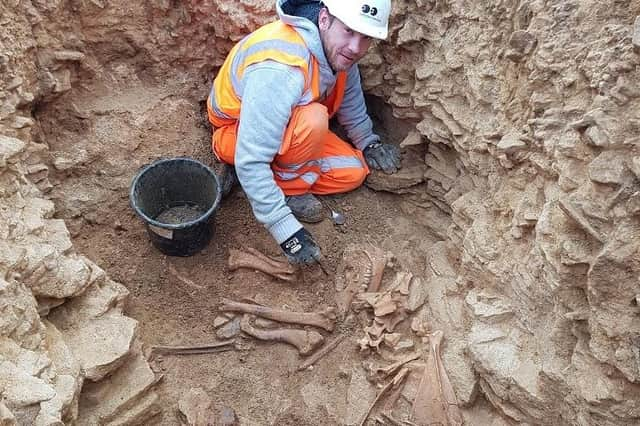Ancient deer sacrifice found by water workers in village


The deer skeletons, found in an infilled pit, are believed to have been killed, possibly as sacrifices, during the Early Bronze Age.
They were the earliest remains discovered during archaeological excavations carried out as part of a huge project to build a new drinking water grid, called SPA, across the East of England.
Advertisement
Hide AdAdvertisement
Hide AdBefore the pipes for SPA are laid by Anglian Water engineers, archaeologists must assess the possible damage that groundworks could do to buried archaeological remains.
This work is carried out in a simple process including geophysical survey, excavation of trial trenches and then targeted open area excavations in locations where the previous surveys have identified important archaeological remains.
The red deer skeletons found in Navenby showed no signs of butchery and were discovered alongside some bell-shaped pottery known as Beaker pottery. This was created by a distinct culture, the people of which have been named The Beaker People, and who originally came from the European continent. The pots began to be seen in Britain about a hundred years later.
The site was then disused until the Iron Age period, a thousand years later, when a small, rural settlement developed and included two roundhouses and five other post-built structures, possibly granary stores, according to experts. This small settlement was in use for a long time, with maintenance and realignments suggesting continued occupation and some redesign.
Advertisement
Hide AdAdvertisement
Hide AdThe focus of activity seems to have shifted towards the Roman period, with the only evidence of Roman activity at the site comprising a human burial and three cremations, indicating perhaps funerals taking place on the edge of a settlement.
Jonathan Hutchings, from the archaeology team helping to deliver the new water grid, said: “These fascinating and significant finds are helping to shape our understanding of what life in Lincolnshire was like many thousands of years ago.
“The red deer may have been left as a sacrifice or offering by Early Bronze Age people. Alternatively, it could have been a sort of ‘funeral’ for the deer, or a way to ward off or attract spirits.
“Our water pipes and pumps are crucial, but our work is also opening a window to the past for communities across the region, giving an insight into their history, heritage and origins – while also helping to enhance our understanding of our national character.”
Advertisement
Hide AdAdvertisement
Hide AdThe SPA water grid is one of the UK’s biggest infrastructure projects. Once complete, hundreds of kilometres of underground, interconnecting pipelines – from Elsham in North Lincolnshire to Essex and Suffolk – will move millions of litres of water a day from wetter to drier areas.
Anglian Water is committed to leaving a long-lasting green and social legacy along the route, donating thousands of books to 11 primary schools, planting new trees, installing dozens of boxes for dormice, bats and owls and donating a defibrillator.
